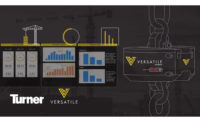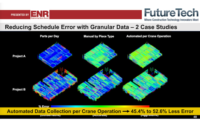Improving construction data practices and finding new ways to use machine-learning and other advanced algorithms in projects has been a hot topic in the industry, but some firms are already seeing real benefits. That was the consensus of a panel of experts convened for ENR’s 2021 Top Young Professionals virtual conference, held Feb. 24-26.
“The situation is unwieldy but quite exciting. Folks can see the art of the possible,” says Jit Kee Chin, executive vice president and chief data and innovation officer at Suffolk. She added that while the construction industry seems to be overwhelmed with many different point solutions, there is an emerging view that better handling and analysis of data is needed across the board. “I think as an organization, you will streamline access to all the data,” she added.
“Algorithms are extremely data-hungry,” says Matt Pappas, chief data officer at Kiewit Data Services. Pappas explains that working with data at a large firm like Kiewit affords him a wealth of project information to throw against his team’s algorithms, but even he has to deal with the often incomplete data-gathering practices in the industry.
Still, even working with sporadic data, his team has developed algorithms for Kiewit's estimating group that have reduced the error rate from an average of 10% to only 1.25% in trial runs. “Right now we’re in the process of getting [that algorithm] into the system of Kiewit Construction,” he says. Algorithms can also be used to calculate the most efficient use of materials during preconstruction, and Pappas says that these data-driven approaches could save Kiewit 40% on estimating takeoff costs for megaprojects. “The industry has a lot of opportunities to evolve with data and analytics,” observes Pappas.
But the benefits of data science aren’t reserved for the big players alone, says Anna Jacobson, senior preconstruction manager with Morley Builders. “Working for a midsized builder is different. We don’t have the same volume of data available to us,” she says. Collecting better data, and building out the systems that will improve the business is often just as much about communication and coordination as it is analytics and data science. “If you’re dealing with an organization that has succeeded through traditional business practices … it’s hard to make a change,” explains Jacobson. “We’re coming at it in a very methodical way, taking it step-by-step.”
Tough Love
But sometimes it takes a little tough love to move things along, says Sam Holden, project executive at Skanska. He recalled one recent project where his team set up all of the project documents and data in the cloud for team members, but some were a bit stuck in their ways and kept doing work offline in Microsoft Excel. The risk this posed to version control and data integrity was beginning to get out of hand, so Holden and his team took drastic measures. “We banned Excel,” he says. While they didn’t uninstall the application from team members’ computers, they issued a rule that project work was to be done in the cloud and set out to build dashboards in PowerBI to collect and analyze relevant information for the team. By building useful tools that the team found superior to their old ways of working, they eventually came around. “Ultimately we were able to get everyone, from our side, from the customer’s side, into one sandbox,” he says.
While construction has come a long way on its data journey in recent years, there is still much work ahead. But the panelists were excited about where things were going, and are seeing the changes accelerate. “Construction has been so dependent on documents,” says Jacobson. “Documents embody data, but they aren’t the data and information itself. We’re going to see that change in the next five to ten years.” Jacobson foresees a not-too-distant future where contractors and other project team members are issued a BIM instead of any drawings, and they will be expected to deliver projects without a document-based environment. “The industry has been the same for 200 years, and all of a sudden it is going to be very different,” she says.
When a question came in from the audience about the threat of ceding too much decision-making control to algorithms or other derivatives of artificial intelligence, Jacobson was quick to point out that it's the busywork, not the high-level decision-making, where this technology will be used the most. “Data is going to be useful for computational tasks, and right now we have a lot of human labor doing that. It’s a mismatch: Humans are not as good at that,” she says. Speaking of her work in preconstruction, Jacobson says she would prefer for a computer to do 80% of the project plan, so that a human could come in then and make the complex decisions about how it all comes together.
Chin agreed that the data-driven advice is intended as an aid, not a replacement. “It’s human affirming,” she says. “It takes on some of the less-exciting work, ideally, and allows us to apply critical judgement.”






Post a comment to this article
Report Abusive Comment